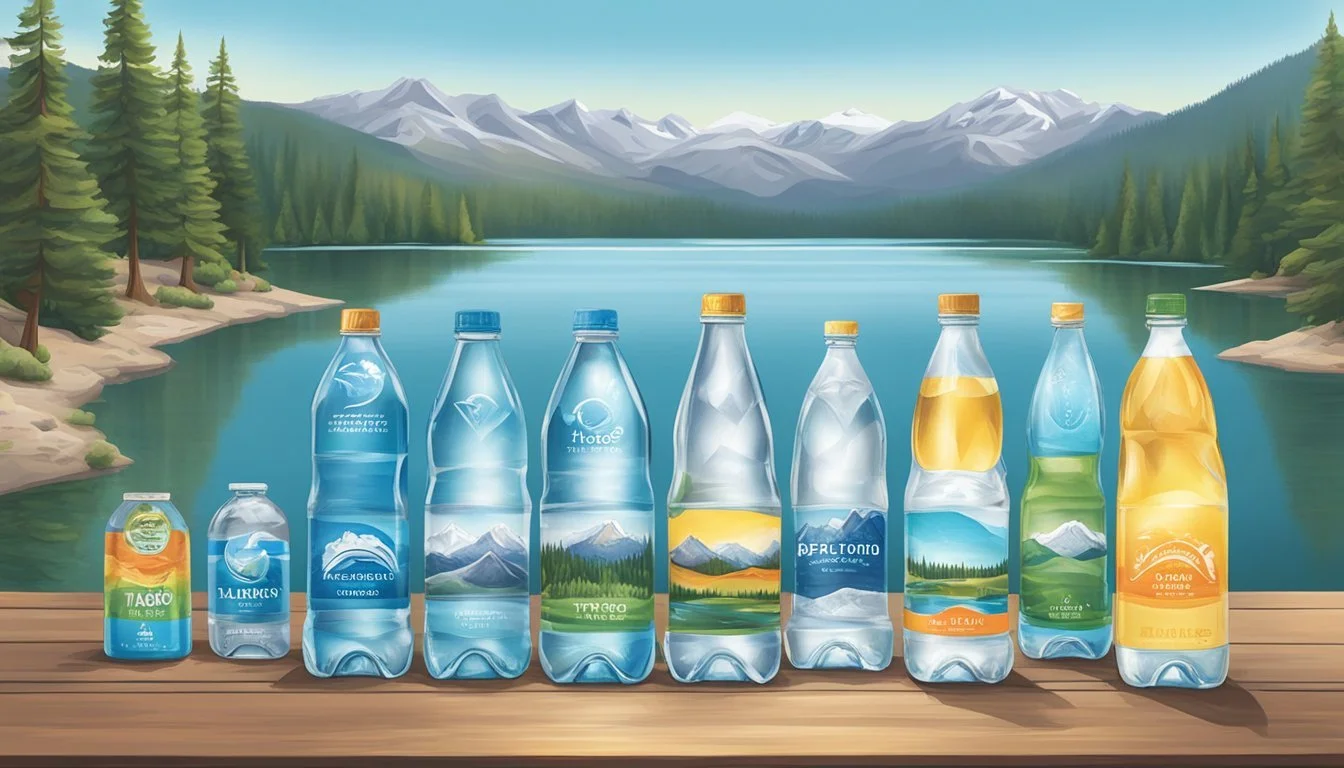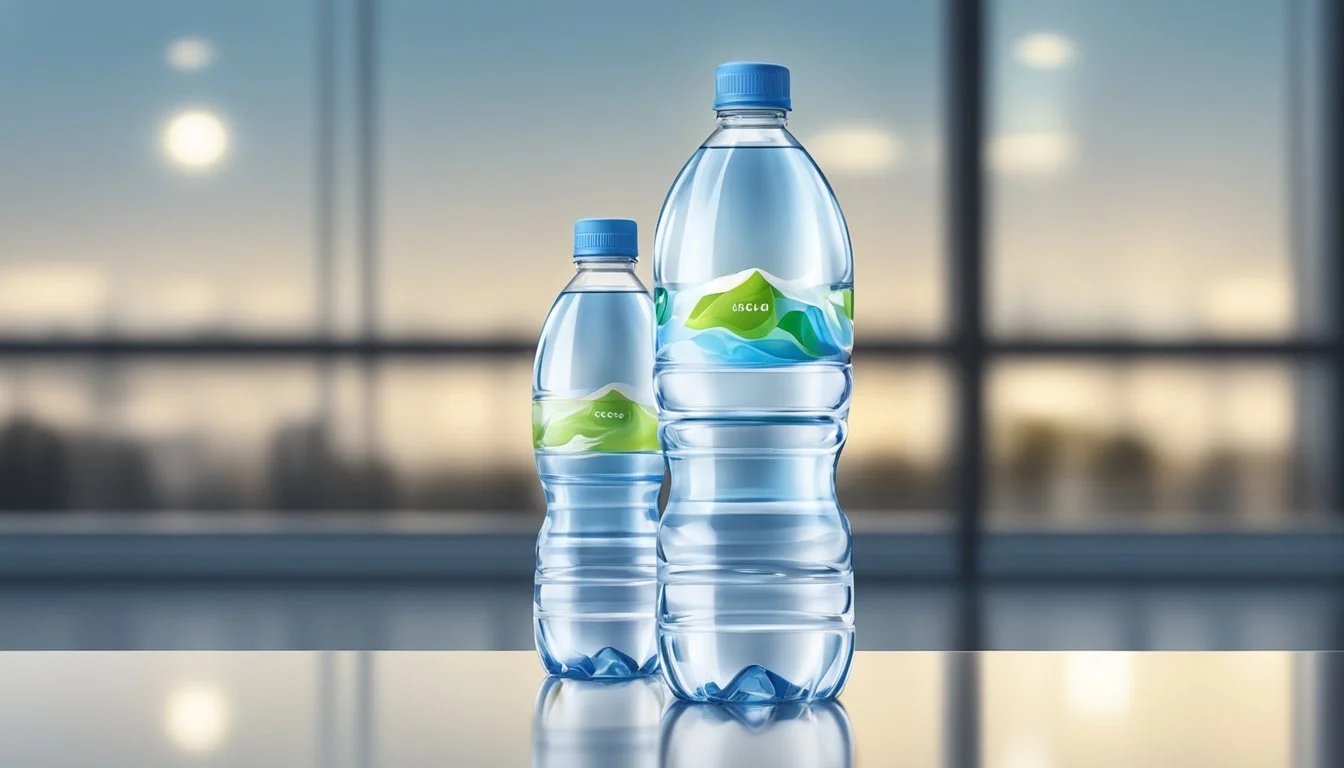Tahoe vs. Proud Source
Which Bottled Water Offers Superior Quality?
When it comes to choosing the best bottled water, consumers often find themselves deciding between Tahoe and Proud Source. Both brands offer unique qualities that set them apart in the saturated bottled water market. Proud Source Water, a relatively new player from Idaho, emphasizes its naturally alkaline water, which many believe offers health benefits.
Tahoe, another well-known brand, is promoted for its pure taste and reliability. Proud Source edges out Tahoe with its eco-friendly practices and emphasis on sourcing naturally alkaline water. Understanding these distinctions can help you make an informed choice.
While both brands offer high-quality hydration, Proud Source extends its appeal with a commitment to sustainability and natural sourcing. These factors make Proud Source an attractive option for those prioritizing both health and environmental impact.
Understanding Bottled Water
Bottled water comes in various forms, each with distinct characteristics. Spring water is sourced from natural springs and often contains beneficial minerals. This type of water undergoes minimal filtration.
Mineral water is rich in naturally occurring minerals and must come from a protected underground source. It’s often sought for its potential health benefits.
Purified water is processed to remove impurities. It can originate from any source, including tap or groundwater. Methods like distillation, deionization, and reverse osmosis are used.
Natural water refers to water that comes from natural sources and has not been altered significantly by human activity. Alkaline water, known for its higher pH levels, is believed by some to neutralize acid in the body.
Natural spring water flows freely to the surface from natural springs. It is often bottled at the source to retain its purity.
Artesian water comes from an artesian aquifer, a confined groundwater source. It’s accessed by drilling and is known for natural pressurization.
Comparison Table
Type Source Key Characteristics Spring Water Natural Springs Contains natural minerals Mineral Water Protected Underground Rich in minerals Purified Water Various (tap, groundwater) Processed to remove impurities Natural Water Various Natural Sources Unaltered, natural state Alkaline Water Alkaline-rich Sources Higher pH level Natural Spring Water Natural Springs Bottled at the source Artesian Water Artesian Aquifer Naturally pressurized
Each type of bottled water offers different qualities, catering to varying consumer needs and preferences.
Assessing Water Quality and Safety
Understanding the specifics of water quality and safety involves evaluating the source, filtration processes, purity levels, and relevant health considerations for both Tahoe and Proud Source bottled water brands.
Source and Origin
Tahoe Bottled Water:
Tahoe bottled water primarily sources its water from Lake Tahoe. This lake is renowned for its pristine clarity and natural purity. Being a large freshwater lake in the Sierra Nevada Mountains, it contributes significantly to high-quality drinking water.
Proud Source Water:
Proud Source Water, in contrast, sources its water from natural springs and aquifers. These sources are often touted for their sustainability and the mineral content naturally present in spring water, which can offer unique health benefits.
Filtration Process
Tahoe Bottled Water:
Tahoe water goes through an extensive filtration process. This includes methods like reverse osmosis and UV treatment to ensure the removal of contaminants while preserving essential minerals. Lake water naturally contains varied substances, necessitating robust filtration for safe consumption.
Proud Source Water:
Proud Source Water's filtration process is designed to maintain the natural properties of spring water. This brand uses minimal interventions, relying heavily on the natural filtration provided by the aquifers. When additional filtration is applied, it's typically carbon-based to remove any potential contaminants without stripping away beneficial minerals.
Purity and Contamination
Tahoe Bottled Water:
Tahoe water achieves high purity through its rigorous filtration techniques. Regular testing ensures that their product is free from harmful contaminants, including bacteria, viruses, and chemical pollutants.
Proud Source Water:
Proud Source Water emphasizes its spring water's natural purity. Testing focuses on identifying and eliminating unregulated chemicals that may leach from plastic bottles. The brand maintains transparency through water quality reports available on their website.
Health Considerations
Tahoe Bottled Water:
Health considerations for Tahoe water include its low contaminant levels and maintained mineral content. Frequent testing ensures compliance with safety standards, making it a suitable option for those seeking reliable, clean drinking water.
Proud Source Water:
Proud Source Water emphasizes the health benefits of its natural mineral content. The minimal filtration process preserves these minerals, which can contribute to daily nutritional needs. Safety standards are upheld rigorously, aligning with FDA guidelines to ensure consumer safety.
Tahoe vs. Proud Source Bottled Water
Tahoe and Proud Source are two distinct bottled water brands each with unique attributes. Key differences include their mineral content, taste profile, and pH levels.
Brand Overview
Tahoe is renowned for sourcing water from Lake Tahoe's pristine environment in the United States. Known for its purity, it emphasizes minimal processing to maintain its natural state.
Proud Source Water originates from Idaho, specifically Mackay. This brand focuses on sustainable practices, touting its eco-friendly operations and commitment to community development.
Mineral Content Comparison
The mineral content in water can influence both health benefits and taste.
Tahoe is noted for its lower mineral content, creating a softer mouthfeel but providing fewer health benefits associated with mineral-rich water.
Proud Source, in contrast, boasts substantial mineral content, including calcium, magnesium, and potassium. Its Total Dissolved Solids (TDS) level of 132 ppm signifies higher minerality, which can enhance flavor and offer additional nutrients.
Taste Profile
Taste is a crucial aspect when comparing bottled waters.
Tahoe water is often praised for its clean, crisp taste with a slight tang, making it highly refreshing and pleasing to many consumers.
Proud Source offers a slightly different experience—characterized as light and slightly sweet, with a velvety texture. Its higher mineral content can add a subtle complexity, appreciated by those who enjoy mineral-rich waters.
pH Level and Alkalinity
pH level is vital in determining water's alkalinity and potential health effects.
Tahoe typically presents a neutral or slightly acidic pH, around 7.0 to 7.5. This range means it's neither heavily alkaline nor too acidic, catering to general preference without any specific health claims.
Proud Source, on the other hand, highlights its alkaline nature with a pH of 8.1. Higher alkalinity can appeal to those seeking benefits like improved hydration and potential acid-neutralizing effects.
Both brands offer unique qualities, letting consumers choose based on their preference for purity, minerality, and pH levels.
Environmental and Sustainability Factors
Understanding the environmental and sustainability factors of bottled water brands is essential. This includes evaluation of their packaging materials, water source sustainability, and company environmental policies.
Packaging
Tahoe and Proud Source use different packaging materials which significantly affect their environmental impact. Tahoe typically uses plastic bottles, raising concerns about plastic waste and BPA (Bisphenol A) contamination. Proud Source opts for aluminum bottles, which are more easily recyclable and have a lower environmental footprint compared to plastic.
Recycled plastic is sometimes used by Tahoe, but it varies. Proud Source's packaging minimizes the use of single-use plastics, promoting sustainability by relying on materials that can be reused multiple times. Evaluating the types of bottles they use reveals much about their commitment to environmentally friendly packaging.
Water Source Sustainability
Tahoe sources its water from natural springs, specifically mountain spring water. This can be sustainable if the extraction methods do not deplete the natural resource. Ensuring that the spring remains pristine is crucial for environmental sustainability.
Proud Source also sources its water from natural springs. They emphasize sustainable sourcing practices that aim to have minimal environmental impact. Regular monitoring and responsible water management practices are key to ensuring that their water sources remain sustainable in the long term.
Company Environmental Policies
Tahoe has some initiatives to reduce its environmental impact, such as using recycled materials to some extent. However, their reliance on plastic bottles highlights an area where more could be done. They need more robust policies and practices to manage and reduce plastic waste effectively.
Proud Source positions itself as a leader in sustainable bottled water. They have comprehensive environmental policies emphasizing the reduction of their carbon footprint, use of recycled and recyclable materials, and advocacy for environmental causes. Their commitment to preserving water sources and minimizing their footprint reflects strongly in their policies.
In summary, both brands take steps toward sustainability, but Proud Source's focus on aluminum packaging and robust environmental policies offer a more innovative approach to reducing environmental impact and enhancing sustainability.
Practical Considerations for Consumers
When choosing between Tahoe and Proud Source bottled water, consumers should consider convenience, packaging, and cost to make a well-informed decision.
Convenience and Availability
Tahoe bottled water is often found in grocery stores and specialty health markets. Its distribution may be limited to regional outlets, primarily around the Lake Tahoe area. For those living outside this region, availability can be a concern.
Proud Source water, meanwhile, has a broader distribution. It can be purchased in convenience stores and various retail outlets nationwide. Proud Source’s wider geographical reach makes it a practical choice for regular grocery shopping.
Summary:
Tahoe: Mostly regional, limited availability.
Proud Source: Nationwide availability, easily accessible.
Packaging and Transport
Tahoe water prides itself on minimal processing to preserve its natural mineral content. However, it uses plastic bottles, which can contribute to pollution. This may be a point of consideration for environmentally-conscious consumers.
Proud Source, on the other hand, uses aluminum bottles. Aluminum is often preferred for its recyclability. This choice reduces environmental impact and offers a sustainable alternative to plastic. Additionally, aluminum bottles are durable for transport and less likely to leach chemicals into the water.
Summary:
Tahoe: Plastic bottles, less sustainable.
Proud Source: Aluminum bottles, more sustainable and durable.
Cost Analysis
The cost of bottled water is a significant factor. Tahoe water, due to its niche market and regional sourcing, can be more expensive. The limited distribution and the emphasis on natural purity influence its price point.
Proud Source, benefiting from larger-scale production and distribution, tends to have a competitive price. The cost is generally lower, making it a more budget-friendly option for consumers seeking daily hydration.
Summary:
Tahoe: Higher cost, niche market.
Proud Source: Lower cost, widely available.
Comparative Analysis of Additional Brands
The bottled water market includes a variety of brands, each with distinct characteristics. An analysis of some popular brands reveals their various features and consumer perceptions.
Dasani and Aquafina are common choices, primarily offering purified water. Both undergo extensive filtration processes but have faced criticism regarding plastic usage and taste.
Evian and Fiji are often associated with premium quality. Evian is known for its mineral-rich profile from the French Alps. Fiji offers a smooth taste sourced from an artesian aquifer in the Fiji Islands.
Arrowhead and Poland Spring emphasize natural spring sources from the U.S. Arrowhead sources from multiple springs, while Poland Spring focuses on springs in Maine.
Voss distinguishes itself with stylish glass bottles and artesian water from Norway. Smartwater undergoes vapor distillation, adding electrolytes for taste.
Acqua Panna from Tuscany, Italy, and Pure Life from Nestlé are other notable brands. Acqua Panna offers a smooth, pH-balanced profile. Pure Life is marketed for its purity and accessibility.
Core Hydration prides itself on being pH-balanced and nutrient-enhanced. Icelandic Glacial is lauded for its pristine glacial source and environmental consciousness.
Flow provides naturally alkaline spring water in eco-friendly packaging. Mountain Valley Spring Water from Arkansas offers classic spring water with a historical reputation.
San Pellegrino and Perrier are famous for their sparkling varieties. San Pellegrino offers a balanced mineral profile, while Perrier is known for its high carbonation and crisp taste.
Boxed Water promotes sustainability with its carton packaging. Nestlé Pure Life and Ice Mountain Natural Spring Water maintain strong market presence through broad distribution and affordability.
Each brand has unique selling points, catering to different consumer preferences regarding taste, source, and environmental impact.
Additional Factors Influencing Water Choice
When comparing Tahoe and Proud Source bottled water, important factors to consider include electrolyte additions, alkalinity, and the availability of flavored and sparkling options. These aspects can significantly affect a consumer's choice based on specific health benefits, taste preferences, and hydration needs.
Electrolyte Additions
Electrolytes, such as sodium, potassium, and magnesium, are essential for maintaining proper hydration and bodily functions. Some bottled waters specifically add electrolytes to enhance these benefits.
Tahoe: This brand typically does not include added electrolytes. It relies on the natural mineral content for hydration and taste.
Proud Source: Proud Source naturally contains minerals from its Rocky Mountain source. While not specifically marketing added electrolytes like sports drinks, its mineral-rich profile aids hydration and replenishes essential nutrients.
Choosing a water with added electrolytes can be crucial for those engaging in intense physical activities or seeking to replenish lost minerals.
Alkalinity and Mineral-Rich Choices
Alkaline water has a higher pH level and is often praised for potential health benefits like neutralizing acid in the body and improving hydration.
Tahoe: Known for its source in the Sierra Nevada, Tahoe water has a neutral pH range, making it a pure and refreshing choice without the specific alkaline benefits.
Proud Source: With a naturally alkaline pH of 8.1, Proud Source offers potential benefits for those seeking alkaline hydration. This higher pH, along with its rich mineral content, can enhance the water's taste and provide additional health benefits.
Consumers might prefer alkaline water for its potential positive effects on overall wellness, particularly for those with acidic diets.
Flavored and Sparkling Water Options
Flavored and sparkling waters provide variety and can make regular hydration more enjoyable.
Tahoe: This brand focuses on offering pure, unflavored water, emphasizing natural quality from its Sierra Nevada source.
Proud Source: Proud Source also sticks to unflavored water, maintaining its commitment to natural alkaline spring water. Neither brand currently provides flavored or sparkling options.
For those looking for a twist on regular hydration, flavored and sparkling alternatives from other brands might be more appealing, offering different tastes while still providing essential hydration benefits. Brands like LaCroix or Perrier often cater to this preference with a variety of flavor options.
Final Considerations and Recommendations
When deciding whether to choose Tahoe or Proud Source bottled water, considering factors such as hydration, sustainability, cost, and health benefits can help you make an informed decision.
Choosing the Right Bottled Water for You
Taste and hydration are key considerations. Tahoe offers a refreshing option with a slight tang, while Proud Source is known for its pure and mineral-rich content. Cost is another factor; Tahoe tends to be more affordable, making it a practical choice for budget-conscious consumers. Health considerations play an essential role as well. Both brands meet stringent quality standards, but their mineral content may vary, impacting the taste and potential health benefits.
Packaging is equally important. Proud Source uses aluminum bottles, which are more sustainable and eco-friendly compared to the plastic bottles often used by Tahoe. Choosing between Tahoe and Proud Source requires balancing these factors to meet your personal preferences and values.
Using Reusable Bottles
The environmental impact of single-use plastic bottles is a growing concern. Reusable bottles are an effective solution for mitigating this issue. Opting for a reusable bottle can reduce waste and promote sustainability. Cost savings are another benefit, as investing in a reusable bottle can be more economical in the long run compared to buying single-use bottled water.
Using reusable bottles is convenient since they can be easily refilled throughout the day. They come in various sizes and materials, including stainless steel, glass, and BPA-free plastic. Many reusable bottles also feature insulation to keep your water cool and refreshing, enhancing the overall drinking experience.
Tapping into Tap Water: A Viable Alternative?
Tap water can be a practical and cost-effective alternative to bottled water. It often meets strict regulations and is subject to regular testing, ensuring it is safe to drink. Utilizing a home filtration system can further enhance taste and remove any contaminants, making tap water a healthier and more sustainable option.
The environmental impact of tap water is significantly lower compared to bottled water. No packaging waste is produced, and energy consumption related to bottling and transportation is eliminated. Convenience is another factor, as tap water is readily available at home and in many public places, offering an always-accessible hydration source.
More About Tahoe
Mountain Valley Spring Water vs Tahoe: Which Bottled Water is Better?
Tahoe vs Richard's Rainwater: Which Bottled Water is Better?
Tahoe vs Whole Foods Italian Still Mineral water: Which Bottled Water is Better?
More About Proud Source
Aqua Carpatica vs Proud Source: Which Bottled Water is Better?
Cascade Mountain vs Proud Source: Which Bottled Water is Better?
Core Hydration vs Proud Source: Which Bottled Water is Better?
Crystal Geyser vs Proud Source: Which Bottled Water is Better?
Crystal Lake vs Proud Source: Which Bottled Water is Better?
Hawaii Volcanic vs Proud Source: Which Bottled Water is Better?
Hawaiian Springs vs Proud Source: Which Bottled Water is Better?
Ice Mountain vs Proud Source: Which Bottled Water is Better?
Icelandic Glacial vs Proud Source: Which Bottled Water is Better?
Kirkland Signature vs Proud Source: Which Bottled Water is Better?
Liquid Death vs Proud Source: Which Bottled Water is Better?
Mountain Valley Spring Water vs Proud Source: Which Bottled Water is Better?
Nestle Pure Life vs Proud Source: Which Bottled Water is Better?
Poland Spring vs Proud Source: Which Bottled Water is Better?
Proud Source vs Essence pH10: Which Bottled Water is Better?
Purely Sedona vs Proud Source: Which Bottled Water is Better?
Richard's Rainwater vs Proud Source: Which Bottled Water is Better?
San Pellegrino vs Proud Source: Which Bottled Water is Better?
Simple Truth vs Proud Source: Which Bottled Water is Better?
Solan de Cabras vs Proud Source: Which Bottled Water is Better?
Talking Rain AQA vs Proud Source: Which Bottled Water is Better?
Whole Foods 365 vs Proud Source: Which Bottled Water is Better?
Whole Foods Italian Still Mineral water vs Proud Source: Which Bottled Water is Better?








